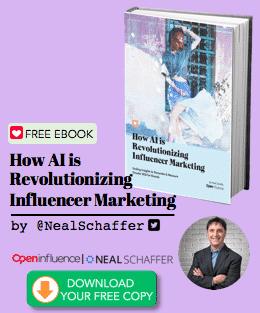On the surface, influencer marketing seems simple enough. Find an online influencer, pay them some money, and watch them drive new faces to your product. Of course, anybody who has ever tried influencer marketing knows that it is far easier said than done to find the right influencer for your brand.
The truth is that not just anybody can sell your product. You could back the Brinks truck into LeBron James’s driveway and offer him the world to push your product to his 40.7 million Instagram followers. But if it’s not something his followers would be interested in, it’s a massive waste of money.
To that point, many marketers who were previously considered an authority on marketing feel that they have not gotten their money’s worth from their influencer marketing endeavors. But this just speaks to how difficult influencer marketing actually is–and in some ways, a misunderstanding of influencer marketing being more about community than a singular campaign. It requires the right marriage of product and influencer – and they both have to be perfect.
Why Finding the Right Influencer Matters

One of the biggest reasons for the success of influencer marketing is that it isn’t perceived the same way as traditional marketing. Everyone knows what ads look like, and consumers have become highly skilled at tuning out conventional advertising messages. Influencer marketing is very successful in this area; when done correctly, it’s a natural extension of an influencer’s personal brand, even when links, keywords, and other standard SEO techniques are used.
Imagine an influencer that does a sponsored YouTube post for a line of makeup. It’s an ad, but at the same time, it’s something far more. She’s simply showing the world what works for her – giving credit to the products that have helped her to capture the public eye. By showing off the makeup, she’s showing pride in being associated with this line of makeup. That combination is likely to inspire several others to follow in the same path of this influencer and report their own glowing reviews to their followers.
That’s the kind of rub you want from your influencer. You don’t want an annoying ad that’s obviously a sales pitch for something the audience of the influencer doesn ‘t care about; instead, you want something more natural, whether that is an article, a blog post, or a post on their social media network. This ad is a paid promotion, yes, but also serves as a convincing and effective statement about why this influencer thinks his or her audience will benefit from learning about this product.
That’s why influencer marketing is so much more powerful than regular marketing: when finding the right influencer to work with, you are tapping into trust that a community has with a relevant influencer that advertisements cannot replicate. In the scope of social media marketing, influencer marketing also becomes more important as organic social media reach for brands trends closer and closer to zero. Of course, this only works after finding the right influencer to work with in the first place.
After all, an influencer search might not be as simple as browsing your own social profiles, and may require you to visit influencer platforms or an influencer database, in order to find influencer profiles and determine your options for a successful collaboration with the ideal influencers for your brand.
The Cost of Getting Influencer Marketing Wrong
Unfortunately, many businesses don’t truly understand the business impact that influencer marketing can have. They end up forcing an ill-fitting influencer, either to keep up with the competition, to appear cutting-edge, to maintain a specific (and too low) budget, or simply because they believed what their agency told them. Perhaps it’s because their agency didn’t do enough due diligence or maybe the brand found someone that “looked good” on an influencer marketplace, without first having a detailed conversation or making sure that the influencers being courted were actually suitable influencers. The end result is a campaign that yields little or no value to a business.
Some influencer marketing campaigns have made brands look bad not only because of their choice of influencer, but also their approach in how they work with that influencer to create promotional content. The cut and paste Instagram post that was published by Scott Disick on behalf of the BOOTEA brand is a case study that is still talked about today. It is the desire to share best practices and case studies to emulate with fellow marketers that fueled my passion to write my most recent book on influencer marketing.
That’s not even the half of it, though. One standard of measuring influencer marketing cost on Instagram has been $10 per 1,000 followers. That might not seem like much, but if you decide to commit to ten posts with an influencer with 100,000 followers, you’ll find yourself $10,000 in the hole. That’s money that might be better spent in a variety of other marketing mediums.
Marketing is never guaranteed, and it’s impossible to tell if your advertising expenditures will directly result in additional business. It’s natural that any marketer would want some assurance that their influencer will move the needle. But much like finding the right influencer and influencer marketing itself, this is far more complex than it seems; authentic engagement does not happen without effort, and finding the right online influencers for your brand requires effort.
How Do You Measure an Influencer’s Influence?

That’s the problem that plagues marketing managers worldwide. There’s undeniable potential in influencer marketing. However, as we’ve seen, there’s much more to influencer marketing than picking a pretty profile picture with lots of followers. It’s the sense of trust and believability that really sell a product or service. And that’s what you need to get from your influencer.
The problem is that it’s very hard to gauge what someone is really about based on their Instagram photos. As we all know, Instagram is a very carefully curated look into someone’s life, one that only shows the good parts. With only part of the story, it’s difficult to know who you’re really dealing with. And worse, there’s no real data to supplement your choice in finding the right influencer.
When considering the personality and interests of potential influencers, the only data at your disposal comes in the form of hashtags. In theory, if someone uses hashtags that are synonymous with your brand, you’ve got a good match on your hands. However, influencers rarely use hashtags these days. Overusing hashtags tends to emit an air of desperation; it suggests that someone is desperate for attention. It’s not a great look for the average person, and it’s even less desirable for an influencer. Remember, the goal is to seem authentic. A giant block of hashtags doesn ‘t accomplish that, and it could lead to a backlash towards both the influencer and your business.
Needless to say, the existence of fake followers and engagement also clouds the picture and makes it further difficult to assess an influencer’s true value.
With hashtags rendered largely useless for influencer marketing purposes and uncertainty about other public metrics, there has to be another way to figure out the perfect influencer for your business. Fortunately, there’s one solution that’s already beginning to make the lives of marketers much easier.
7 Tips on Finding Social Media Influencers Organically in Your Niche or Industry
1. Google Search – for “[your niche/industry] experts”, “[your niche/industry] influencers”, “[your niche/industry] speakers or “[your niche/industry bloggers]”
![Google Search - for "[your niche/industry] experts", "[your niche/industry] influencers", "[your niche/industry] speakers or "[your niche/industry bloggers]"](https://nealschaffer.com/wp-content/uploads/nathana-reboucas-O5v8heKY4cI-unsplash.jpg)
Running a quick Google search for experts and influencers can often yield quite a large number of people in your area, and can help you stumble across many different potential collaborators in a single, fell swoop. Tagging your searches with your area makes sure you are selecting influencers who are more likely to work with you, and will be better equipped to manage local issues, versus working with large-scale or nation-wide companies. These influencers may be more likely to partner with smaller businesses, and complete posts across several platforms, including Instagram, Twitter, and Facebook, which ensures you are reaching larger audiences, and producing content across several different platforms.
2.) Browse Speaker Lists for Industry Conferences or Virtual Summits
Combing through speaker lists for conferences and summits in your industry can be a wonderful way to locate potential collaborators who resonate with your audiences, because it ensures that you are dealing with people–even micro-influencers–in your field, who are already producing the type of content that matches the content you are working to develop.
Browsing speaker lists does not guarantee that a certain person will collaborate with you, but can be effective, because it can give you a larger framework from which to work, and can give you a quick list for many different possibilities.
3.) Hashtag Search on Instagram – for those using hashtags related to your niche/industry, product, or competitor

Searching hashtags on Instagram pulls double duty: you are able to locate people who might be able to work with your company successfully, and you are able to see content from different audiences’ points of view.
Searching for your niche, product, and competitor is also valuable, because it can let you know what your target audience is after, and the other blogs and content creators who are producing similar content. Using hashtag searches can help you stumble upon social media profiles you might not encounter through a simple Google search, and can help you identify the types of people you are trying to reach.
4.) Search Influencers’ Twitter Lists for Other Influencers
Influencers love to run in packs, as linking to one another’s content on their respective social media platforms allows them to expand their reach and increase their audiences. Viewing Twitter lists for other possible collaborators helps you target other people in the same sphere, and gives you a much larger pool of people to select from when looking for people to collaborate with.
5.) Competitor’s Followers and Engagers on Social Media – who follow and engage with your competitors

Although your competitors might seem like the last people you want to engage with, paying close attention to your competitors and their followers is a powerful strategy for making sure you are reaching every possible audience you can. Whether you peruse the Twitter accounts of your closest competitors, or you focus on their other social media accounts, you want to make sure you take note of who follows your competitors and who actually engages with them through comments, likes, and shares.
6.) YOUR Followers and Engagers on Social Media – you never know the hidden influencers that lurk in your audiences
Don’t forget to use one of the best resources at your disposal: your existing accounts! Your Twitter, Instagram, Face, LinkedIn, and other social media sites are all likely to have at least one person who has a solid following, and reaching out to that individual can do wonders for improving your reach and increasing the amount of people who are consistently accessing your work.
Even if someone does not necessarily have the tag “influencer” in their profile, reaching out to people who have a relatively large reach can accomplish the same effect. Someone with several thousand followers can share your content or posts, and those posts can create a domino effect that allows you to substantially increase the number of people you are engaging with on a regular basis. Over time, those people could easily become the strongest customer base.
7.) Your Customer Database – append your customer database with social media handles and search for nano and micro – influencers that are already your customers!

While many companies will send their products to influencers for free as a way to encourage further advertisement, why send a product for free when one has already been purchased? Go through existing customers, identify any social media handles attached to nano or micro – influencers, and reach out to them, asking them to post their opinions about your product.
Some will do this for free, while others will do this in exchange for something akin to a discount code for themselves or their followers. If you construct your business to accommodate discounts, this process will not cost you much extra money–if any at all–despite providing you with a far more significant reach than your current marketing efforts.
12 Tools to Help You Find Social Media Influencers
Finding Social Media Influencers
1. Keyhole
Keyhole is a social media tool used to find people who are already discussing your company or brand. With varying plan levels–including various price points–Keyhole can be used for small companies, just starting out in their marketing efforts, and larger companies, with several years of marketing campaigns and efforts under their belts. Keyhole provides a seamless and simple way to monitor different social media platforms, blogs, and websites, to locate mentions of your products, in order to better understand who is using and talking about your company, brand, or products. Keyhole can also provide monitoring and use of your own social media profiles.
Finding Instagram Influencers Tools
2. HypeAuditor
HypeAuditor is a tool used to sort through all potential Instagram and YouTube influencers, in order to connect you with as many professionals as possible who can partner with your brand. HypeAuditor does not merely find influencers, however; it also analyzes their content and the brands they partner with, effectively deducing their audience, and the likelihood of their being willing to work with you and your brand.
While HypeAuditor may be primarily used as a way to locate influencers, it can also be used as a tool to track your existing marketing campaigns and evaluate the campaigns of your direct competitors. Using HypeAuditor for both of these purposes allows you to connect with and work with influencers and evaluate your competition in a single, easy to use platform.
3. Influence.co
Influence.co is an influencer marketing platform primarily designed for influencers to create their own social platform, but is also used as a solid means of connecting brands and companies and influencers who are available for work. Far better than a Google search or similar method of finding influencers, that may be rife with false starts and people in whom you are not interested, influence.co allows you to search for specific types of influencers and allows you to reach out with the possibility of working together.
Users on influence.co are influencers and companies, alike, and are using the site primarily as one among many influencer marketing tools, in order to more effectively connect with people from similar backgrounds and with similar needs, whether they prefer broaching a topic on Facebook, Instagram, or another social platform altogether.
4. Post for Rent
Post for Rent is another influencer marketing platform that connects people who touch on a similar topic, and brands and companies that might be interested in working with those individuals. From the brand/company end, Post for Rent allows you to connect with a list of people who might drive engagement to your site, and allows you to manage your existing influencer marketing strategy. Post for Rent also allows you to relinquish control of your marketing content and strategy, allowing the creators behind the site to manage your content and strategies.
This last step is most often taken by larger companies, but can be useful for companies of any size that are managing more than one influencer relationship at any given time. Users can utilize the site without this feature, and maintain complete control over their strategies and campaigns.
5. Influencity
Influencity is designed for novices and experienced companies alike, providing tools to connect with influencers with whom you can work, manage campaigns, and develop improved strategies. Influencity helps differentiate between influencers who have amassed a following through honest, organic means and those who have purchased or otherwise come by followers inorganically, to make sure your campaigns are not being wasted.
Influencity is an award-winning platform, and has worked with brands as large as Samsung and Kellogg. Backed by a substantial team, working around the clock to provide consistent customer service to Influencity users, Influencity has a solid history of linking influential people, consistently driving traffic, and allowing influencing marketers and brands to get together and successfully develop marketing campaigns.
6. Heepsy
Heepsy allows users to find relevant influencers by sorting through possible matches with a minimum of 5,000 or more followers. Heepsy also allows you to analyze the audiences of niche influencers, influential bloggers, and other influencing professionals, in order to make sure that you are partnering appropriately and developing campaigns that will successfully drive traffic and improve engagement, whether that engagement is delivered via Twitter posts, blog posts, or Instagram or Facebook posts.
Heepsy also allows companies to compile their strategies and plans in a single, convenient place, streamlining marketing campaigns and analyzing which Tweets, posts, and blogs are effectively encouraging traffic, and which are no longer serving the brand.
7. OpenInfluence
OpenInfluence is a large influencer marketing tool, garnering business from companies as large and well-known as Honda and Verizon. Influencer marketing platforms like OpenInfluence allow you to craft an image with influencers, who use their platforms to drive traffic and improve awareness of your brand. OpenInfluence accomplishes this through connecting brands and businesses with influential people on social media platforms.
OpenInfluence reaches all around the world, both in terms of brands and influencers. With a proven track record, and a truly enormous base of influencers and brands, OpenInfluence acts as a one-stop shop for all things social media marketing and influencer marketing.
Finding Twitter Influencers Tools

8. Buzzsumo
Buzzsumo is a unique site, in that it operates in four important arenas: searching, researching, connecting, and evaluating. Whether it is scouring Twitter for influential tweets, conducting hashtag searches to find related influencers, or going through the authors of the best social media posts, Buzzsumo provides brands with a way to search for with new influencers, evaluate their backgrounds and abilities, connect them with brands, and keep a close eye on all existing campaigns to evaluate any tweets, posts, or campaigns that are not performing.
Buzzsumo functions as a social authority, and increases the chances of brands connecting with relevant influencers and successfully developing social network based marketing campaigns.
9. Followerwonk
Followerwonk is a Twitter-specific search engine that helps brands develop relationships with influencers in order to craft successful marketing campaigns through influencer Tweets. The lists of influencers found on Followerwonk are designed to create successful connections. Followerwonk can be used as a way to connect with people of all backgrounds, and is not merely a tool for effective influencer marketing.
Followerwonk can help people find people of all backgrounds and intentions on Twitter, and can be used by professionals and laypeople, alike. Followerwonk can also be useful as a means of comparing your own social media posts to your competitors and can help you filter and sort through the most successful way to use Twitter to improve your brand.
10. Brand24
Brand24 identifies itself as the “social listening” tool, which essentially operates as a search bar for your brand name, whether that is through brand mentions, content in response to your marketing campaigns, or other sources of brand-specific content. Although it focuses primarily as a search bar to locate your brand, Brand24 also functions as a filter through which you can locate the type of influencers who are more likely to use and mention your products or brand, in order to develop successful social media marketing campaigns using influencer marketing.
Tools to Help Find Bloggers & Podcasters

11. Respona
Respona combines automation with targeted work to create a unique influencer discovery tool. While many social media marketing tools focus primarily on standard social platforms and do not filter for any additional sources of influencers, Respona targets bloggers, specifically, to create a list of bloggers to improve your brand’s reach–one of the many benefits of influencer marketing campaigns.
Rather than spending months poring over hashtag searches and hoping to encounter blogs that might be able to successfully partner with your brand, you can use Respona to sort through the sea of online content to locate bloggers who can help promote your brand. With Respona, you can shave months off of your workload, and continually partner with well-known and trusted bloggers.
12. Postaga
Postaga automates reaching out to social media users who might be able to partner with your brand to pursue the type of followers your brand is in need of, and helps you search for influencers who best match your brand. Postaga was created to automate successful reaching-out efforts, to increase the likelihood of your ideas reaching your followers to increase the type of engagement you need to improve marketing campaign success.
Postaga allows you to craft specific messages, questions, and requests, which can then be automatically sent to prospective collaborators. Postaga can also help you locate contacts to match your needs, along with their social media information, in order to more effectively communicate with influencers, to create high quality content and pursue successful content marketing efforts.
How Artificial Intelligence Levels the Influencer Marketing Field for Marketers

Recent developments have enabled savvy marketers to mine data from social media posts – not just mere hashtags that might be irrelevant – to glean information about industry influencers. Combined with first-party data from previous campaigns, various public data, image recognition technology, and sophisticated machine learning, artificial intelligence is enabling marketers the ability to peek behind the curtain in a way that’s virtually unfathomable, including the identification of fake influencers or influencer campaigns that are not successful in their efforts.
Now, marketers can really see what these influencers are all about – their disposition, the brands they like, their personality traits, and their personal sites. Marketers can also equally better understand social influencers’ track record, and, most importantly, their audience and the relevance they have to the influencer’s content.
In other words, the things that make influencers influence are now able to be seen, categorized, and reported on in marketing databases. This makes choosing the right influencers for a given marketing campaign markedly easier than ever before and almost guarantees a higher ROI versus not using this technology to “vet” influencers. It also significantly speeds up the process of finding influencers and ensures you’ve used technology to help you find the most relevant ones to create a guest post and draw in a relevant audience.
The impact of this technology can’t be understated. No longer will marketers have to play guessing games regarding finding the right influencer they choose by poring over popular hashtags or try to guess how much influence that they have. We won’t have to question the ROI of influencer marketing and instead use PDCA to find the right mix of influencers to work with to generate the results that we want for our sites and brand materials, including securing loyal customers.
Further Reading: AI and Virtual Influencers: What is Their Role in Influencer Marketing? (with examples)
We’re just at the tip of the iceberg regarding how AI can improve influencer marketing. To learn more about how artificial intelligence is helping marketers win and generate much higher ROI in influencer marketing, download the ebook “How AI is Revolutionizing Influencer Marketing” that I have just published. This book goes in-depth into issues marketers face in modern influencer marketing, and discusses the ways in which artificial intelligence is rendering those issues obsolete. In essence, reading this ebook will help you understand the past, present, and future of influencer marketing.
To download the ebook, click here.

Has your company been “burned” by influencer marketing? Have you had good luck at finding the right influencer? Have your experiences been all positive? Feel free to share your experiences with the influencer community–celebrities in their own right–below. Thanks!
Photo by Mateus Campos Felipe on Unsplash









